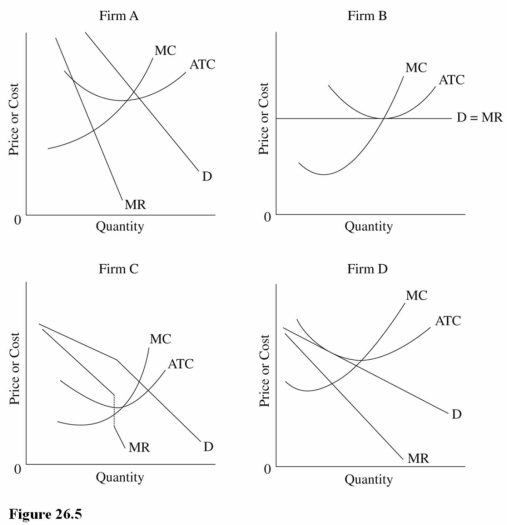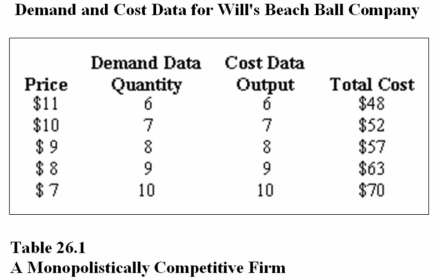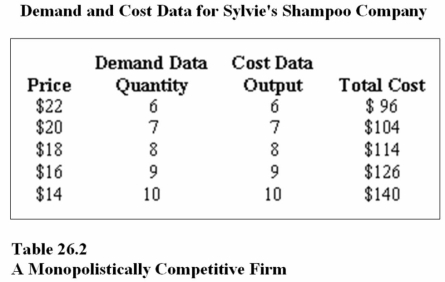A) Not lose any of its customers.
B) Lose most of its customers.
C) Lose some of its customers, but nowhere close to all its customers.
D) Lose all of its customers.
Correct Answer

verified
Correct Answer
verified
Multiple Choice
A concentration ratio measures the
A) Proportion of industry output produced by all firms.
B) Proportion of industry output produced by the largest firms.
C) Dollar value of total industry output produced by all firms.
D) Dollar value of total industry output produced by the largest firms.
Correct Answer

verified
Correct Answer
verified
True/False
Modest shifts of the market marginal cost curve will have no impact on the production decision of a monopolistically competitive firm.
Correct Answer

verified
Correct Answer
verified
Multiple Choice
Both perfect competitors and monopolistic competitors
A) Experience product differentiation.
B) Earn zero economic profit in the long run.
C) Find prices pushed to the minimum of long-run ATC by entry.
D) Use marginal cost pricing.
Correct Answer

verified
Correct Answer
verified
Multiple Choice
When new firms enter a monopolistically competitive industry, the market
A) Supply curve shifts to the left.
B) Supply curve shifts to the right.
C) Demand curve shifts to the left.
D) Demand curve shifts to the right.
Correct Answer

verified
Correct Answer
verified
True/False
A distinguishing characteristic of monopolistic competition is that there are many firms in an industry.
Correct Answer

verified
Correct Answer
verified
Multiple Choice
 Which firm in Figure 26.5 is most likely a monopolistically competitive firm in the long run?
Which firm in Figure 26.5 is most likely a monopolistically competitive firm in the long run?
A) Firm A
B) Firm B
C) Firm C
D) Firm D
Correct Answer

verified
Correct Answer
verified
Multiple Choice
The competitive dimension of monopolistic competition is that
A) High barriers to entry tend to push economic profits toward zero.
B) Consumers view each firm's products as interchangeable.
C) Low barriers to entry tend to push economic profits toward zero.
D) Each firm in the industry will lose all of its customers if it raises its price.
Correct Answer

verified
Correct Answer
verified
Multiple Choice
Compared to the outcome under a marginal cost pricing strategy, a monopolistically competitive firm will produce a
A) Lower output and charge a higher price.
B) Greater output and charge a higher price.
C) Lower output and charge a lower price.
D) Greater output and charge a lower price.
Correct Answer

verified
Correct Answer
verified
Multiple Choice
Which of the following market structures will have lower output in the long run than perfect competition, ceteris paribus?
A) Monopolistic competition, but not oligopoly or monopoly.
B) Monopolistic competition, oligopoly, and monopoly.
C) Monopolistic competition and oligopoly, but not monopoly.
D) Oligopoly and monopoly, but not monopolistic competition.
Correct Answer

verified
Correct Answer
verified
Multiple Choice
In monopolistic competition, the entry of new firms will cause all of the following to happen except
A) Long-run economic profits will be zero.
B) The industry cost curves will shift to the left.
C) The firm's demand curve will shift to the left.
D) The market supply curve will shift to the right.
Correct Answer

verified
Correct Answer
verified
Multiple Choice
A World View article titled "The Best Global Brands" discusses the value of brand names. Establishing brand loyalty can do all of the following except
A) Improve resource allocation efficiency.
B) Decrease the price elasticity of demand for the product.
C) Become a valuable economic asset.
D) Increase demand for the product.
Correct Answer

verified
Correct Answer
verified
True/False
Advertising plays a role in reducing the cross-price elasticity of demand.
Correct Answer

verified
Correct Answer
verified
Multiple Choice
If economic profits are earned in a monopolistically competitive market,
A) More firms will enter the market.
B) The market supply curve will shift to the left.
C) Price will rise.
D) The market demand curve will shift to the right.
Correct Answer

verified
Correct Answer
verified
True/False
Concentration ratios for monopolistically competitive markets typically fall in the range of 70 to 100 percent.
Correct Answer

verified
Correct Answer
verified
Multiple Choice
Entry into a market characterized by monopolistic competition is generally
A) Entirely blocked by existing firms.
B) Very easy because few barriers exist.
C) As difficult as in oligopoly.
D) More difficult than entry into monopolized markets.
Correct Answer

verified
Correct Answer
verified
Multiple Choice
 Refer to Table 26.1. In order to maximize profit, Will's Beach Ball Company should produce _______ and charge a price of _______ each.
Refer to Table 26.1. In order to maximize profit, Will's Beach Ball Company should produce _______ and charge a price of _______ each.
A) 6 beach balls; $11
B) 7 beach balls; $10
C) 8 beach balls; $9
D) 9 beach balls; $8
Correct Answer

verified
Correct Answer
verified
Multiple Choice
Which of the following is not true about a monopolistic competitor?
A) It maximizes profit at the point where MC = MR.
B) It produces less output than a perfectly competitive firm, ceteris paribus.
C) It charges a higher price than a perfectly competitive firm, ceteris paribus.
D) It can earn economic profits in the long run.
Correct Answer

verified
Correct Answer
verified
Multiple Choice
 Refer to Table 26.2. To maximize profit, Sylvie's Shampoo Company. should produce _______ bottles of shampoo and charge a price of _______ each.
Refer to Table 26.2. To maximize profit, Sylvie's Shampoo Company. should produce _______ bottles of shampoo and charge a price of _______ each.
A) 6; $22
B) 7; $20
C) 8; $18
D) 9; $16
Correct Answer

verified
Correct Answer
verified
Multiple Choice
Which of the following characterizes the difference between oligopoly and monopolistic competition?
A) Oligopolists are independent of each other; monopolistically competitive firms are interdependent.
B) Monopolistically competitive firms experience zero long-run economic profit; oligopolists may experience positive long-run economic profit.
C) There are many oligopolists but only a few monopolistically competitive firms.
D) Monopolistically competitive firms face horizontal demand curves; oligopolists face downward-sloping demand curves.
Correct Answer

verified
Correct Answer
verified
Showing 61 - 80 of 149
Related Exams